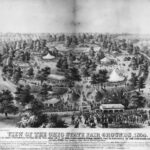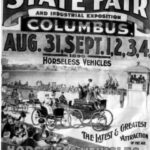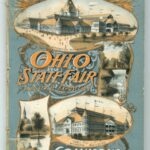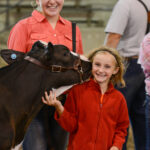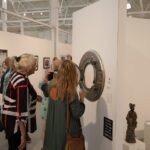by Collette N. McDonough, CA. Collette is a member of the SOA Advocacy and Outreach Committee.
As a young person, the summers meant many things to the city pool, mowing the grass, but the peak of summer fun was the fair. I was a 4-H kid, and the county and state fairs were a big deal for me. I participated in the animal science program, specifically the equine division. I loved going to the Washington County Fair each year and to the Ohio State Fair when I qualified. So, I’m happy to contribute this blog post about the Ohio State Fair that features materials from the Ohio History Connection.
Most Ohioans would assume that our state fair has always been held in Columbus, but the fair bounced around the state well into the 1880s, taking place in Cincinnati, Dayton, Newark, Toledo, Zanesville, Cleveland, Mansfield, Sandusky, and Springfield before its permanent and current home in Columbus was finished in 1886. The first Ohio State Fair was held in 1850, just outside of Cincinnati.
In the early days of the fair, it was a little more difficult to get people and exhibitors from across the state to attend, but the railroads played a key role. According to the Ohio State Fair history webpage, “Special rates were offered whereby exhibits were transported without charge, and the exhibitor rode for half fare. Several central Ohioans contributed to the first Fair, including Alfred Kelley, owner of the Columbus and Xenia Railroad Company.”
In 1854, the fair was held in Newark. Judging by the illustration, most of the tents were set up within the earthworks.
In 1896, the fair featured new technologies like the horseless carriage and electric lighting. Most Ohioans in the 1890s lived on farms, and this would likely have been their first time seeing the wonders of the modern age. The average city in 1890s would have only used gas lamps, and electricity is considerably less dangerous and cleaner. This was the first time electric lighting was used at the fair, allowing for horseracing after dark. Automobiles would not become a regular sight on Ohio’s streets until well into the first decade of the 20th century.
The 1904 fair was still mostly an agricultural event, with most exhibits related to agribusiness. Many of the equine classes were in relation to pulling a cart or wagon and judging the animals as breeding stock. Other animals that were included were chickens, cows, pigs, turkey, and ducks. Another important event was the judging of farm products corn, wheat, tobacco, butter, cheese, and maple syrup. Winning an event at the fair could prove lucrative to farmers since a ribbon was proof of the high-quality commodities that were produced on their farm. If you were able to win first or second place, there was prize money included with both top spots. A first-place prize winner could earn $2, which is worth about $70 today.
In addition to the images accompanying this post, the Ohio History Connection has many resources on the state fair that have been scanned into the amazing resource that is Ohio Memory, the collaborative statewide digital library program of the Ohio History Connection and the State Library of Ohio. This free website allows you to explore digital content from almost 400 cultural institutions from around that state.
In 2023, the Ohio State Fair’s record-setting attendance was just over a million people. While it has thrived for close to 175 years, there have been a few times that it was cancelled or paired down. During the Second World War, the fair was canceled, and the grounds were used for the war effort. The fair was canceled again in 2020 due to Covid, and in 2021 it was only open to fair competitors.
The Ohio State Fair has always included a huge variety of activities. Most young people go for the rides, but attendees can also check out art exhibits, dog agility demonstrations, and the All-State Ohio Fair Band and Youth Choir. And, of course, there are the farm animals being shown by kids in 4-H and FFA, if that is more your style.
This year’s fair will take place from July 24 to August 4 and is sure to be a fun time. The fair usually attracts some big names in entertainment, and this year’s line-up includes Alabama, Boys II Men, Ice Cube, and many more. Tickets to see the bigger name performers are an extra cost.
So, check out Ohio Memory for more on the history of the Ohio State Fair, and if you head to the fair in Columbus later this summer, be sure to see the butter sculptures and grab yourself something fried to eat!
Last Updated on August 23, 2024 by Emily Gainer

